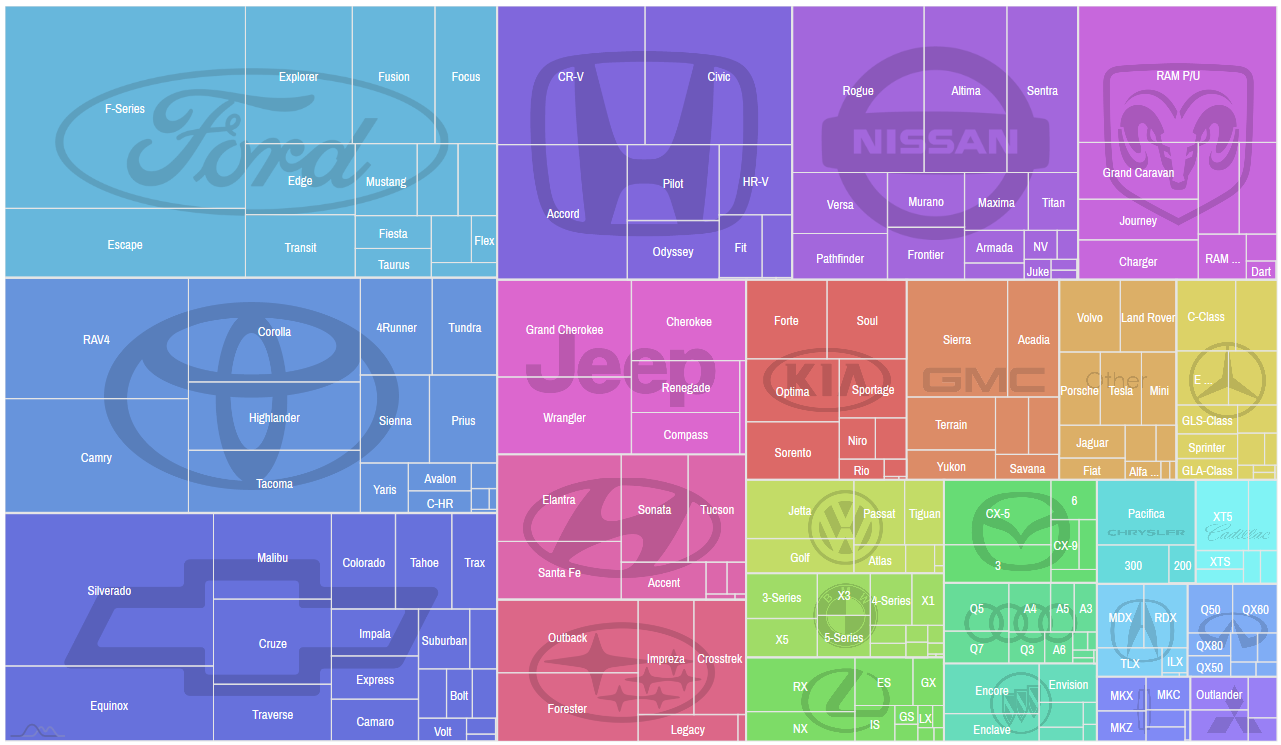
A deeper look into that category will elicit more insights and naturally draws attention to your message. For example, a sales report may want to highlight a specific month. In your work, use the uneven branching to emphasize and draw attention to a single slice, further teasing apart the contributions. The Sunburst unveils that the “Children’s Books” Genre has Sub-Genres that extend into specialty topics.

Sunburst also wins in adding the dimension of depth to each parent branch. From the Sunburst, we know “ABCs” and “Tolstoy for Tots” are grouped together under the “Age 3-5” parent group. Upon further analysis of the “Children’s Books” at the top-left of Treemap, the Sub-Genre of “Age 3-5” is not shown, whereas the Sunburst adds that additional layer of information in the same colored slice. A Treemap loses the categories in the middle.
TREEMAP CHART FULL
When space is not an issue, Sunburst shines through by painting the full picture of the hierarchy and thereby illustrating the different depths of hierarchical groups. Space that could be used to tell a story with your data is lost in the corners. Treemaps are optimized to show lots of data, because it stretches to within its bounding box, whereas plotting a Sunburst is fitting a circular chart into any rectangular window. Just in the way our minds differentiate size and shape, rectangles and straight lines are easier to compare than slices and angles. Treemaps, by their rectangular nature, are better suited for comparison among hierarchical levels. Regardless of the format of your hierarchical data, you can create a Hierarchy Chart by clicking the Treemap or Sunburst icon on the Insert ribbon to reveal insights into your data.Īfter getting acquainted with the concept of hierarchical data and the Treemap and Sunburst charts, you might wonder, “Why use one over the other?” The answers lie in what information you want to convey in the chart. If all the cells were filled out, like in the example below, a Treemap or Sunburst chart can still be created. In the case of an empty cell, the parent category is the previous (or above) line item. In a sparse hierarchy form of data, like the example above, the parent-the category that represents a collection of data points (e.g. Recognizing data within a hierarchy is intuitive and simple. Topic is a subset of Sub-Genre, while Sub-Genre is a subset of Genre. These naming conventions create a hierarchical dataset. Notice the table headings: Genre, Sub-Genre and Topic. The example below, following a small bookstore inventory, illustrates the look and feel of hierarchical data. Hierarchical data just requires some level of order and organizational structure. They can be organizations within a business, regions within a country, makes or models of a product, or disciplines within a subject. Hierarchical datasets are perfect for layers within the data where natural groupings exist. Get started What is hierarchical data and what does it look like?

Read the overview of general settings: General Settings.Best-in-class productivity apps with intelligent cloud services that transform the way you work.

In An圜hart there are many settings that are configured in the same way for all chart types, including the Treemap chart (for example, legend and interactivity settings). In the sample below, there is a basic Treemap comparing the top 10 most populated European Union countries by their population: // create dataĬhart = eeMap(data, "as-tree") To create a Treemap chart, use the eeMap() chart constructor. The Treemap chart requires adding the Core and Treemap modules: You can also see the table below to get a brief overview of the Treemap chart's characteristics:
TREEMAP CHART HOW TO
This article explains how to create a basic Treemap chart in An圜hart as well as configure settings that are specific to the type. The sizes and colors of rectangles are proportional to the values of the data points they represent. Triple Exponential Moving Average (TRIX)Ī treemap is a visualization that displays hierarchically organized data as a set of nested rectangles, parent elements being tiled with their child elements.Moving Average Convergence Divergence (MACD).


 0 kommentar(er)
0 kommentar(er)
